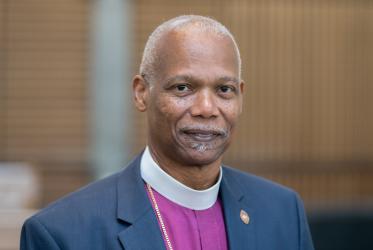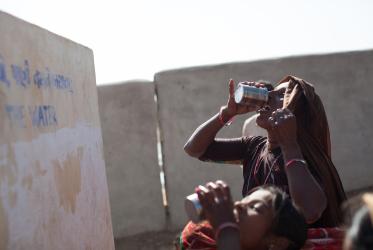Text: Genesis 16:6-14; Genesis 21:15-16
Reflection
The access to clean fresh water is vital for all of humanity, but for women in particular, water access and collection means the difference between life and death for them and their families.
The stories of Hagar in the book of Genesis are interesting because both are attached to water. In the first instance Hagar flees Sarai’s mistreatment and is found by the angel of the Lord sitting near a spring of water. The angel tells her to return with a prophetic promise that her unborn child will have many descendants. Hagar names the water by which she sat as “Beer Lahai Roi” – Well of the Living One who sees me (Gen 16:6-14).
When we meet Hagar again, she is mother to a teenage Ishmael, who is older brother to the heir-apparent, Isaac. Immediately, the text reveals that Sarah is vexed with Ishmael and after accusing him of “mocking”, demands that Abraham get rid of Hagar and her son. The promise of Ishmael growing into a great nation is repeated, this time to ease his father’s guilt. Abraham then casts Hagar and his son into the Beersheba wilderness with some food and a “skin of water” (Gen 21:9-14). Hagar, now no longer a slave tastes the bitter sweetness of freedom as she wanders a desert wasteland with her son, some food, and a “skin of water” which by some estimates equated to 3.7 litres.
The text doesn’t say how long it took for this amount of water to finish under the extreme conditions, but by the time it does, Hagar is bewildered and inconsolable as she leaves her dying son under a bush to die (Gen 21:15-16). Hagar cannot save Ishmael, showing the thin line between life and death when water is scarce.
Once again, the angel of the Lord comes to the rescue, opening Hagar’s eyes to a well of water; the One who sees now opens her eyes to see and she is able to save Ishmael and keep alive God’s promise.
The story of Hagar crying in the wilderness represents the feminization of water poverty. She is sent out into the desert with less than 4 litres of water which Abraham thought sufficient for two people, one being his son. It is left up to Hagar to figure how she will manage the water during this difficult journey in the wilderness and still keep Ishmael alive. The text tells us that when the water is finished, she places Ishmael under a bush and sits about half a mile away because she cannot bear to see him die. What may seem a heartless thing for a mother to do could be an act of despair as she is unable to find water for her son.
Hagar’s story is the story of women everywhere, including in the Pacific, where droughts and water shortages threaten the livelihood of communities. According to some figures, women and girls around the world spend 200 million hours every day collecting water for their family and communities.[1] Women can be found waiting in long lines for water and will pay exorbitant prices to gain access to safe drinking water for their families and communities. Like Hagar, they are responsible for the survival of their loved ones as they keep dehydration and illness at bay, while ensuring sanitation and hygiene is provided for clean living spaces.[2]
The rural highlands and western side of Fiji’s main island often have droughts where nearby local water sources dry up during months of dry season. Women and girls can walk 2-4kms one way to reach the nearest river where they wash, bathe, and collect water for their families back in the village. An arduous and back-breaking task, the concern over security especially for young girls comes into question. In these parts, surviving droughts can determine familial roles, especially when there is little to no water remaining. Men farm what they can from the parched land, women sell the produce for income, and often it is the daughters who stay home from school to look after younger siblings, care for the home, and collect water.
Girls can walk long distances to fetch waters, when local water sources dry up. This leaves them vulnerable to harassment and even assault. In the Pacific context there is the added need of using water for the social drinking of kava, pressuring women to keep water for the “mix.” This can lead to domestic disputes between husbands and wives, further adding to the social impact water poverty has on families, communities, and especially on women.[3]
The feminization of water poverty highlights the burden that women and girls carry in finding water for their families. Like Hagar, when the water source runs out, they are responsible for the survival of their loved ones. The plight of Hagar’s experience in the desert is limited to her dying son, even God does not listen to her cry but to Ishmael’s.
There is no question about how long she searched for a spring or oasis before their “skin of water” ran out? Did Hagar ration the water in hope that Ishmael would survive before finding a spring? How much of the water did Hagar drink herself? Generally speaking, a mother’s love will sacrifice most if not all the water so that her child should live. So, did Hagar drink? Was she hoping to find the ‘Beer Lahai Roi’ spring? Did she get confused in the blazing desert because she herself was dehydrated and dying? What does happen when women and girls go looking for their local water source and it is no longer there?
The irony of reflecting on water poverty in the Pacific is that the world’s most famous branded water is from the region – “Fiji Water.” A clear bottle with illustrations of the lush tropics and quintessential hibiscus that subliminally states, “You are drinking a piece of Paradise!” But while the world celebrates and readily drinks up what is marketed as “Earth’s finest water,” the capitalistic mindset prone to rich nations is yet to stop and ask, how much water is left in the aquifer, and will the company completely drain it up? How many more natural aquifers will foreign multinationals source from the Pacific before they stop? Do they care about the people and lands from which they are taking? Or does the commodification of water cause them to be blind to the injustices of their actions.
Access to fresh water is increasingly becoming problematic in the region. There is a risk that 4.3 million people in 12 Pacific nations could be at risk from changing rainfall patterns, leading to drought severity on one hand and intensified storms on the other.
Parts of Fiji’s main island affected by droughts are reliant on water deliveries, and this is for areas where water authorities can deliver. Rural villages and communities have no choice but to find other water sources such as creeks and rivers which may be miles from where they live. There is also the issue of intensified cyclones which flood, contaminate, and shut down natural water sources.
Outside of Fiji are lower than normal rainfall in parts of Micronesia, causing moderate to severe droughts. The Marshall Islands declared a state of emergency in 2016 when 13 atolls officially requested assistance from their government to address water shortages. Palau has recorded the lowest rainfalls since 1951 with some parts put on emergency water rations. In Papua New Guinea about 40% of people have access to fresh drinking water and in 2016 dry spells on their islands affected the food security of 1.5 million people. Over in Tuvalu and Tokelau there were water shortages in 2011 leaving their countries with one week’s supply of water. The Pacific is feeling the effects of the impending global water crisis, most especially at the rural community level where accessing safe drinking water is felt hardest.
But at the heart of the issue are women and girls who like Hagar, will trek distances for life-giving water to ensure the survival of their families and communities. Like Hagar, whose full experience in the desert is silenced,[4] the experiences of Pacific women can get lost in reports, studies, and research that address water poverty in the region. Should their struggle be silenced and their fight to have access to clean fresh water denied, then like Hagar, they too risk the possibility of losing their children and the next generation of Pacific Islanders to water poverty.[5]
Questions:
- Discuss whether it was unjust of Abraham to send Hagar and Ishmael into the desert with one skin of water. What does this say about the attitude towards water between women and men?
- Should the Pacific region protect its fresh water sources from foreign multinationals who are in the business of commodifying water overseas? Why or why not?
Actions:
- Let the girls and young women in your congregation write to a young girl in the Pacific who collects water for the survival of her family.
- What would you say to encourage her? Is there something you can learn from her situation? Don’t just see her as a victim, but as someone who is strong and resilient. Include your name, country, church, and a photo if possible.
- What can you do in your country to show support and solidarity with girls and young women in the Pacific who do not have immediate access to safe drinking water?
- Send the reflections to the PCC Stewardship Team in Suva for translation to a few Pacific languages. PCC as well as your congregation can compile selected parts of the reflections into pamphlets which are sent out to churches for distribution to encourage young girls and women.
Additional Resources:
- https://www.unicef.org/press-releases/unicef-collecting-water-often-colossal-waste-time-women-and-girls
- https://www.theguardian.com/environment/2011/oct/04/south-pacific-water-crisis-rainfall
- https://reliefweb.int/disaster/dr-2015-000127-fji
- http://www.climateaction.org/news/water_shortages_spread_around_the_pacific_islands
- https://www.worldbank.org/en/news/feature/2018/03/20/papua-new-guinea-clean-water-access-to-end-the-walk-for-water-for-women-and-girls
[1] https://www.unicef.org/press-releases/unicef-collecting-water-often-colossal-waste-time-women-and-girls
[2] Notes from Mereani Nawadra
[3] Observational experience obtained through discussions with Ms. Frances Namoumou who worked 4 years in the Navosa highlands (Western Viti Levu).
[4] The text is silent on Hagar’s experience in the desert. Did she go searching for water but couldn’t locate an oasis? Was she harassed? Did she drink or give most of it to Ishmael so he could survive?
[5] “Hillside Pool” Acrylic on rag by Diana Crooke




